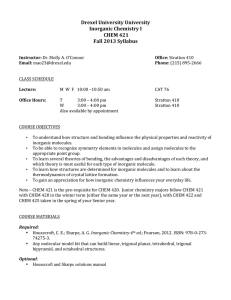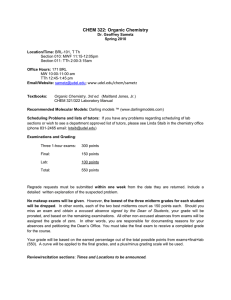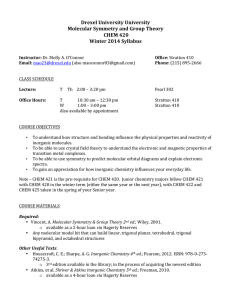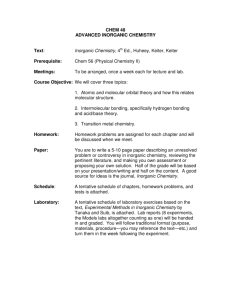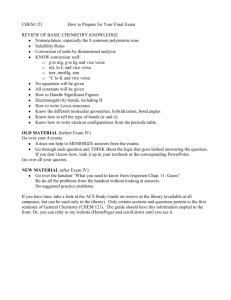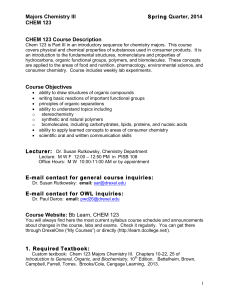CHEM.422 Spring 2015, “Inorganic Chem. II”.
advertisement
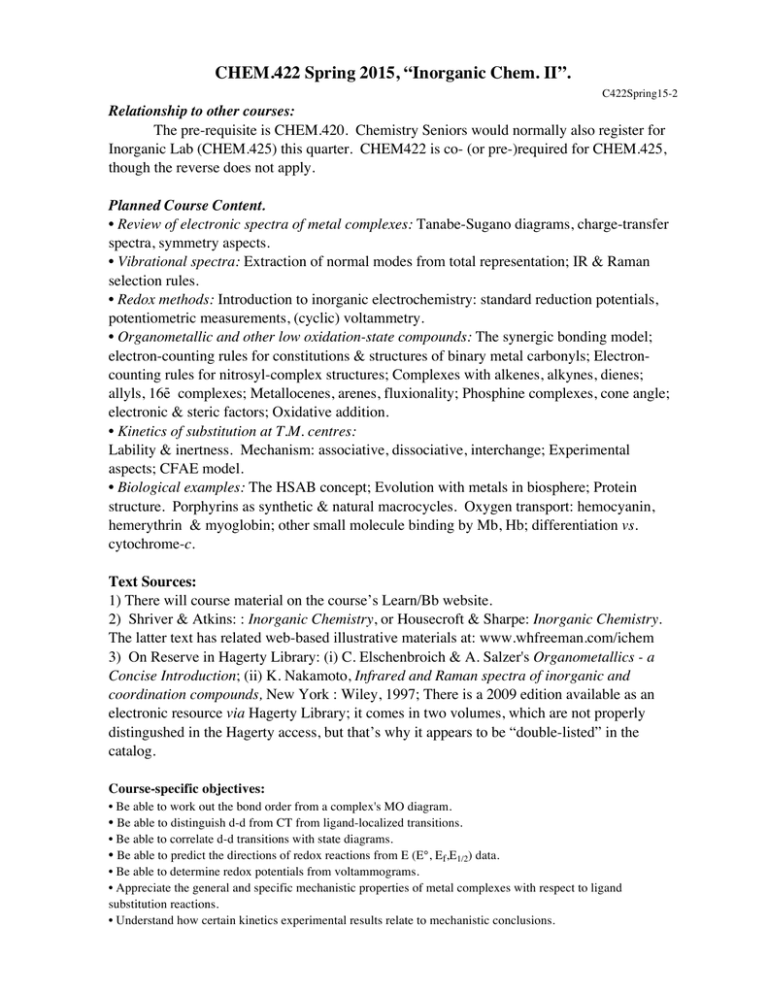
CHEM.422 Spring 2015, “Inorganic Chem. II”. C422Spring15-2 Relationship to other courses: The pre-requisite is CHEM.420. Chemistry Seniors would normally also register for Inorganic Lab (CHEM.425) this quarter. CHEM422 is co- (or pre-)required for CHEM.425, though the reverse does not apply. Planned Course Content. • Review of electronic spectra of metal complexes: Tanabe-Sugano diagrams, charge-transfer spectra, symmetry aspects. • Vibrational spectra: Extraction of normal modes from total representation; IR & Raman selection rules. • Redox methods: Introduction to inorganic electrochemistry: standard reduction potentials, potentiometric measurements, (cyclic) voltammetry. • Organometallic and other low oxidation-state compounds: The synergic bonding model; electron-counting rules for constitutions & structures of binary metal carbonyls; Electroncounting rules for nitrosyl-complex structures; Complexes with alkenes, alkynes, dienes; allyls, 16e- complexes; Metallocenes, arenes, fluxionality; Phosphine complexes, cone angle; electronic & steric factors; Oxidative addition. • Kinetics of substitution at T.M. centres: Lability & inertness. Mechanism: associative, dissociative, interchange; Experimental aspects; CFAE model. • Biological examples: The HSAB concept; Evolution with metals in biosphere; Protein structure. Porphyrins as synthetic & natural macrocycles. Oxygen transport: hemocyanin, hemerythrin & myoglobin; other small molecule binding by Mb, Hb; differentiation vs. cytochrome-c. Text Sources: 1) There will course material on the course’s Learn/Bb website. 2) Shriver & Atkins: : Inorganic Chemistry, or Housecroft & Sharpe: Inorganic Chemistry. The latter text has related web-based illustrative materials at: www.whfreeman.com/ichem 3) On Reserve in Hagerty Library: (i) C. Elschenbroich & A. Salzer's Organometallics - a Concise Introduction; (ii) K. Nakamoto, Infrared and Raman spectra of inorganic and coordination compounds, New York : Wiley, 1997; There is a 2009 edition available as an electronic resource via Hagerty Library; it comes in two volumes, which are not properly distingushed in the Hagerty access, but that’s why it appears to be “double-listed” in the catalog. Course-specific objectives: • Be able to work out the bond order from a complex's MO diagram. • Be able to distinguish d-d from CT from ligand-localized transitions. • Be able to correlate d-d transitions with state diagrams. • Be able to predict the directions of redox reactions from E (E°, Ef,E1/2) data. • Be able to determine redox potentials from voltammograms. • Appreciate the general and specific mechanistic properties of metal complexes with respect to ligand substitution reactions. • Understand how certain kinetics experimental results relate to mechanistic conclusions. • Be able to predict whether a given metal centre is inert or labile by applying a CFAE model. • Use the 18e rule to correlate electron counts with molecular composition. • Be aware of important exceptions to the 18e rule. • Learn about some examples of binding of unsaturated hydrocarbons to transition metals. • Be able to use a metallocene MO scheme to correlate properties with valence electron count. • Be able to correlate electron count with nitrosyl complex composition & stereochemistry. • Be able: to correlate steric effects for ligands in relationship to their cone angle values. • Be aware of various essential or undesirable rôles of metals in biological chemistry. • Be able to relate examples of structural differences amongst metalloprotein active sites with metalloprotein function. Other stuff: Work on the problem sets when I provide them ! Attempt to solve the homework problems as soon as we have covered the material in class. If you do not do the homework, you will find it hard to pass the exams, and virtually impossible to get a good grade. Your grade is based on the (usually three) exams: two midterms (25%, 30%) plus a final exam (45%); this distribution will be modified if I assign graded homework for points. Otherwise-passing graduating seniors who take the final exam receive a 7.5% grade bonus. If you are not registered in the course, no exams will be graded or returned. Remember that I subtract points on exams for incorrect spelling of chemical terms, particularly: valence (not that I'm so keen on this term anyhow), pyramid/pyramidal, fluorine, fluorescence, etc. The 10-Minute Rule: If I'm more than ten minutes late, consider the class cancelled. If you are going to be more than ten minutes late for a class or need to leave early, please have the courtesy to inform me beforehand. My grade ranges are: D= 43-45; D+=46-49; C–=50-53; C=54-56; C+=57-59; B–=60-64; B= 65-69; B+=70-75; A–=76-83; A=84-91; A+=92-100. Much communication about exams, problem sets, etc., will be by email, but don’t let this comment discourage you from coming to see me ! Make-Up Exams ? You don't need an excuse to take the make-up exam if you miss a midterm or final. You can take a makeup for no more than one exam, but you must attend the make-up at the designated time and place or take a zero on it - no excuses. Tentative midterm dates are April 21st & May 21st. The final exam, required unless you successfully petition for an exemption, will be held during the exams period - June 9th-13th. The make-ups will likely be held on the 12th or 15th. Graduating Seniors might wish to review the university policies on Final Examinations and Senior Privilege (http://www.drexel.edu/provost/policies/pdf/examinations_grading_options_v1.pdf) Other university policies include: Academic integrity: http://www.drexel.edu/provost/policies/academic_dishonesty.asp Disability accommodations: http://www.drexel.edu/oed/disabilityResources/ Dropping courses: http://www.drexel.edu/provost/policies/course_drop.asp Broader context of the 422 goals, in terms of the abilities to be reinforced in the curriculum: use theory to understand/predict experimental observations use the physical principles upon which chemical instrumentation is based utilize information from scientific papers use the universal physical laws as they apply in chemistry (e.g., enthalpic and entropic factors applied to reactions and properties) use models and theories carry out calculations related to specific chemistry topics apply molecular understanding of chemical reactivity and materials apply energetics and kinetics of chemical transformations state the properties of elements and compounds recognize the connections between different courses/sub-disciplines in chemistry apply problem-solving skills (identifying the objective) use math and logic to understand data and results reduce complex problems into simpler components Prof. Addison: 12-418; 215-895-2646; AddisonA@drexel.edu
